Identification of “Pistachio” Colored Pearls Treated by Ballerina Pearl Co.
ABSTRACT
Cultured pearls from Pinctada margaritifera can exhibit a broad range of natural bodycolors, including various pistachio-like colors ranging from greenish yellow to yellowish green. Bead-cultured pearls from P. margaritifera, treated by Ballerina Pearl Co. and possessing intense pistachio colors, have entered the market. Similar to Ballerina’s “chocolate pearls,” these pistachio colors are usually modified from natural gray to dark gray colors by a series of chemical and physical processes. No foreign coloring agent was detected in this study, and the treatment was generally stable. Cultured pearls treated by Ballerina’s method can be identified by their appearance, UV-Vis-NIR reflectance spectra, Raman photoluminescence, and different UV fluorescence intensities under DiamondView imaging. Other experiments indicated that bleaching may not play a significant role in changing the color of these pearls. The processes may involve sophisticated chemical and physical techniques that can turn natural gray colors into stable pistachio colors.
INTRODUCTION
Most Tahitian cultured pearls from Pinctada margaritifera exhibit neutral and near-neutral colors, with a large percentage showing black, dark gray, and silvery gray bodycolors; less frequently encountered natural hues include yellow and green. Some white specimens may also be produced from the mollusk (Strack, 2001). In addition to these bodycolors, various overtones such as pink, green, and blue often result from the reflection and interference of incident white light (Elen, 2002; Goebel and Dirlam, 1989; Cartier et al., 2012; Karampelas et al., 2011a). Fancy color descriptions such as pistachio (yellowish green to greenish yellow) and peacock (dark green-gray to blue-gray with pink to purple overtone) have also been widely used to describe certain color ranges in cultured pearls from P. margaritifera.
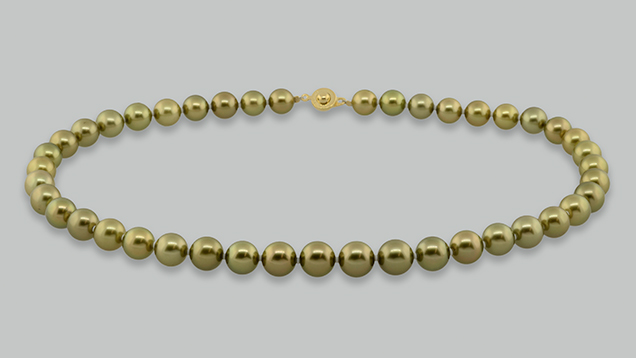
Tahitian cultured pearls are often only washed and lightly tumbled after harvest and then sorted into broad categories: size, shape, color, and luster (Gemological Institute of America, 2011). GIA’s laboratory has previously reported on “chocolate pearls,” Tahitian cultured pearls grown in P. margaritifera and treated by Ballerina Pearl Co. (Wang et al., 2006; Du Toit et al., 2008). Ballerina subsequently produced pistachio-colored pearls using similar starting materials: naturally colored gray to dark gray Tahitian cultured pearls with various modifying hues and overtones (figure 1). These pearls show more intense and saturated hues than those usually seen in natural-color pistachio pearls grown within this species.
The present study focuses on the identification of treated pistachio cultured pearls using both standard gemological testing methods and advanced instrumental techniques. Ballerina was asked to treat 12 Tahitian cultured pearls specifically for this study. Naturally colored pistachio cultured pearls were also examined, and the results were compared with their treated counterparts. Lastly, several simple experiments were conducted to confirm whether a bleaching process was the mechanism that produced this unusual pearl coloration.
MATERIALS AND METHODS
A total of 12 Tahitian bead-cultured pearls with dark gray to dark greenish gray colors, ranging from 8.80 to 12.25 mm, were treated by Ballerina Pearl Co. using its proprietary processes. Eight of these pearls were supplied by Ballerina, and four additional samples were obtained from various sources. Eight naturally colored pistachio pearls from P. margaritifera were also tested in this study (figure 2). These naturally colored pearls exhibited a yellowish green hue similar to that of the treated cultured pearls. They were selected by experienced gemologists from multiple reliable sources, including two in Fiji. Finally, nine additional Tahitian cultured pearls were used in chemical treatment experiments conducted at GIA.
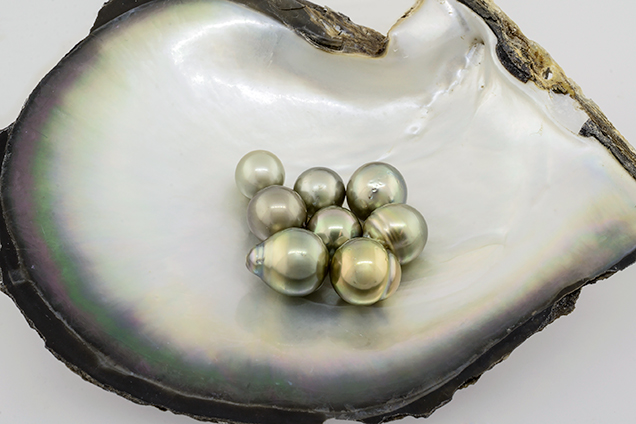
The pearls were examined with a standard gemological microscope; the microscopic images were obtained using a Nikon SMZ 1500 stereomicroscope. The fluorescence reaction was observed in a darkened room using a conventional 4-watt long-wave (365 nm) and short-wave (254 nm) lamp. UV-Vis-NIR reflectance spectra were obtained with an Ocean Optics USB 2000+ UV-Vis-NIR spectrophotometer. Fluorescence images were recorded using a DTC DiamondView instrument (<225 nm excitation). The 12 samples were also tested with a Thermo Scientific Nicolet Nexus 6700 FTIR spectrometer equipped with a KBr beam splitter, a Thermo Scientific ARL Quant’x EDXRF spectrometer, and a Renishaw inVia Raman microscope under 514 nm laser excitation (1800 l/mm grating, 15 s, and 100–1800 cm–1 spectral range for Raman analysis; 1800 l/mm grating, 12 s, and 518–850 nm spectral range for Raman photoluminescence analysis).
Chemical stability tests were carried out by immersing three treated pearls in ethanol, acetone, and isopropanol, respectively, for six hours at room temperature. Bleaching experiments were conducted on all studied pearls using various chemical solutions and household products. Stabilized 3% hydrogen peroxide, a common antiseptic solution, was used for mild bleaching tests. A more concentrated hydrogen peroxide (up to 15%) was prepared by diluting a 30% stabilized H2O2 purchased from Sigma-Aldrich. Adding ammonium hydroxide to activate the hydrogen peroxide’s bleaching capability ensured a basic pH environment of 8–9. Occasional heating up to approximately 65°C for four to six hours during the treatment period of one to four days was conducted to facilitate any possible reaction. Schwarzkopf Premium Lift 9+ hair bleach powder and Premium Care Developer (6% hydrogen peroxide) were used for all bleaching experiments; directions on the product packaging were followed (mixing approximately 35 g of powder with 50–90 g of developer to create a rich bleaching cream).
RESULTS
General Observations and UV Fluorescence. Prior to treatment, the 12 Tahitian cultured pearls exhibited dark gray to dark greenish gray colors with fair to good luster (figure 3, left). Post-treatment color changes varied, with most of the pearls showing a decrease in tone and an increase in yellow and green hues (figure 3, right). The most prominent color changes were observed on three samples provided by Ballerina (BA 02, 04, and 06), where the dominant hue changed from dark gray to yellowish green or greenish yellow. Three pearls turned from dark gray to brown with various modifying hues (BA 08 and GIA 01 and 02). Two pearls remained gray but were slightly modified by a green hue (BA 01 and 05). The remaining four pearls did not show a significant enough color change to move to another range in GIA’s Pearl Color Grading Reference Chart. Slight changes within the same color range were still noted on some specimens; both the bodycolors and the apparent overtones of these pearls changed. Changes in overtone varied from sample to sample—for instance, from pink and green to strong pink in BA 02, but from pink and green to none in BA 04. In many cases, the green overtone became the dominant color or modifier. Luster generally remained unaltered, although three samples showed slight improvement after treatment. No obvious UV fluorescence was observed under either long-wave or short-wave UV. A summary of these observations is listed in table 1.
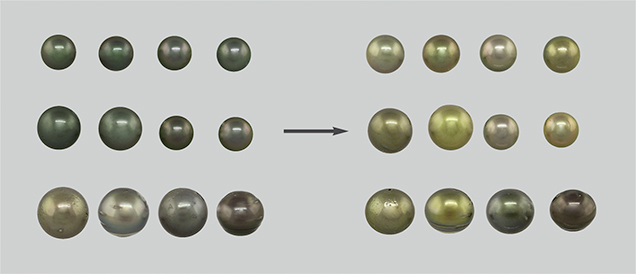
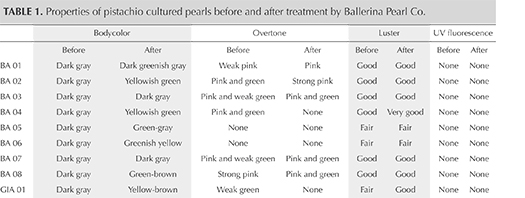
In contrast, naturally colored pistachio pearls showed subtle yellowish green to greenish yellow bodycolors. They had lower saturation and lighter tone than the treated samples. They were mostly inert under both long-wave and short-wave UV, except for one with lighter tone that showed weak yellow fluorescence. A summary of these observations is listed in table 2.
| TABLE 2. Gemological properties of natural-color pistachio cultured pearls. | |||||
| Bodycolor | Overtone | Luster | UV fluorescence | ||
| N 01 | Greenish yellow | Green and pink | Very good | None | |
| N 02 | Yellowish green | Green and pink | Very good | None | |
| N 03 | Green-gray | Green and pink | Good | None (LW); very weak yellow (SW) | |
| N 04 | Yellowish gray | None | Fair | None | |
| N 05 | Green-gray | None | Fair | None | |
| N 06 | Light green-gray | None | Fair | None | |
| N 07 | Yellowish green | Green and pink | Good | None | |
| N 08 | Yellowish green | Green and pink | Good | None | |
Microscopic Observation and DiamondView Imaging. Microscopic observation of natural-color Tahitian cultured pearls revealed overlapping nacre platelets formed by aragonite crystals, with organic conchiolin materials between each layer. The conchiolin materials were a mixture of beta-chitin and an assemblage of acidic glycoproteins (Levi-Kalisman et al., 2001). No dye concentration was observed on the surfaces after treatment (figure 4). Pearls with numerous white blemishes were specifically chosen for this treatment, and the blemish areas were not altered even though the nacre around them changed color. Overall, the treatment produced an even surface color, as opposed to the spotty and patchy coloration found in many dyed pearls. Polishing lines were also observed on some samples, and Ballerina later confirmed that polishing was part of the treatment process (A. Auerbach, pers. comm., 2014).
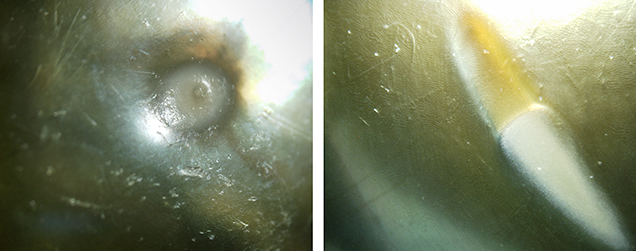
Although observation under UV light is not very helpful in identifying treated pistachio pearls, fluorescence images captured using the DiamondView with its ultra-short-wave UV source (<225 nm excitation) proved useful. Under the same testing conditions, both untreated dark gray and pistachio pearls showed moderate to strong bluish fluorescence, while treated pistachio pearls were consistently inert (figure 5). The strong bluish fluorescence in natural-color Tahitian cultured pearls and the inert reaction in treated samples were consistently observed under the same experimental conditions. Only sample GIA 03 still showed a strong bluish fluorescence after treatment. It was also the pearl that showed almost no color change, so we suspected that this pearl was not effectively treated by Ballerina. The results suggested that DiamondView imaging might be useful for identification of other color treatments in pearls, although this was beyond the scope of the study.
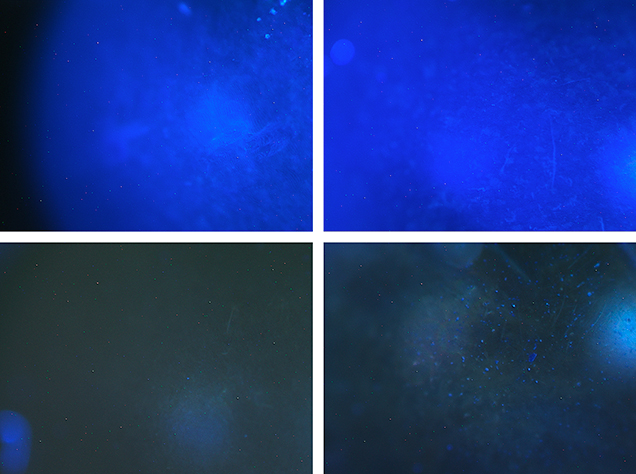
UV-Vis-NIR Reflectance Spectra. The naturally colored dark gray to dark greenish gray P. margaritifera pearls generally showed a distinct reflectance feature at 700 nm, with a relatively flat spectral pattern in the 400–600 nm region. Small features were observed at around 405 and 495 nm, consistent with previous studies (Karampelas et al., 2011a,b). Treated pearls with obvious color changes showed a reduced reflectance toward the lower visible region, with broader, more prominent reflectance troughs around the 405 nm region than before treatment. Unlike treated chocolate pearls, where the 700 nm absorption feature becomes weaker and less distinct after treatment (Wang et al., 2006), the feature was generally unaffected in pistachio pearls (figures 6 and 7). Three of the 12 samples (BA 07, GIA 03, and GIA 04) showed little UV-Vis-NIR spectral difference before and after treatment, as their colors were generally unchanged and treatment was not very successful. Finally, the spectra of natural-color pistachio pearls showed subtle reflectance features in the 400 nm region, compared to the deep troughs found in many treated pearls (figure 8). The characteristic 495 nm feature seen in many naturally colored gray, black, and brownish pearls was also observed in our naturally colored pistachio samples, consistent with an earlier study on light to medium yellow and greenish yellow pearls from P. margaritifera (Elen, 2002). The 495 nm feature was significantly diminished, and in some cases removed, in the treated pearls.
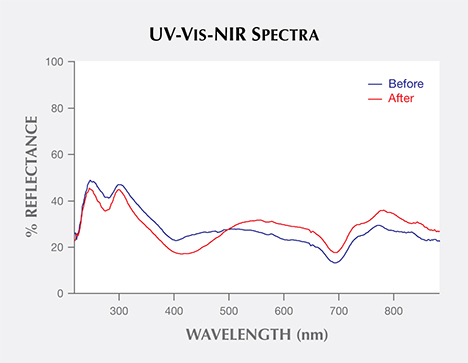
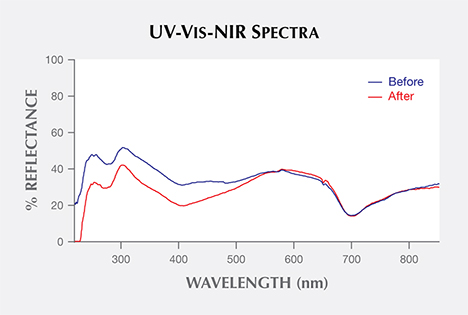
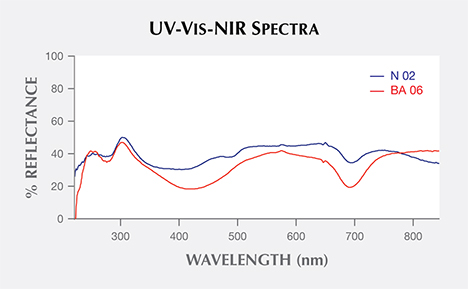
Raman and Photoluminescence (PL) Spectroscopy. Raman spectra (not shown) of both untreated and treated pearls generally showed various vibrational modes of aragonite, the main component of pearls. Previous studies have demonstrated that Raman spectroscopy can pinpoint natural pigments in freshwater pearls (Karampelas et al., 2007), and may even detect tiny pigment peaks related to porphyrin in both Pinctada margaritifera and Pteria sterna cultured pearls (Kiefert et al., 2004). This technique was not very useful for detecting natural pigments in our samples due to overall high fluorescence background. To better visualize the fluorescence characteristics of these pearls upon laser excitation, we collected Raman photoluminescence (PL) data. We found that shells of various mollusk species can show the same distinct triple-peak PL spectra pattern at around 620, 650, and 680 nm under 514 nm laser excitation (figure 9). Similar observations have been noted previously (Karampelas et al., 2011b). These features are most prominent in Pteria species such as P. sterna and P. penguin, and to a lesser degree in Pinctada margaritifera. Both untreated dark gray Tahitian samples and naturally colored pistachio pearls showed a similar triple-peak pattern to the shell samples we studied earlier, while the treated pearls exhibited a flattened (or less defined) area at around 650 nm and also showed stronger fluorescence.
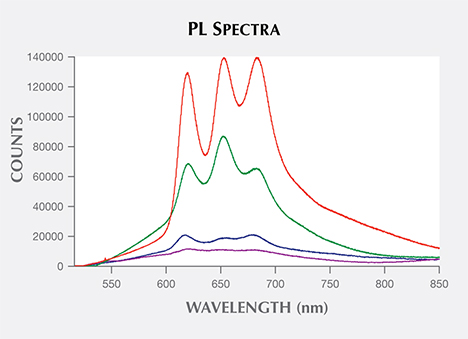
A more useful way to look at the fluorescence is to compare the ratio between the highest fluorescence intensity (in the 600–700 nm region of the spectra) and the main aragonite Raman peak at 545 nm (which correlates with the Raman shift band at 1085 cm–1), as previously used in identifying treated golden pearls (Zhou et al., 2012). Comparing fluorescence to the aragonite Raman peak ratio gives a more consistent relation between the peak signal and background fluorescence intensity of the pearl; this is more useful than looking at the absolute counts of the fluorescence or aragonite Raman peak alone. Our results indicated that naturally colored pistachio pearls generally showed a lower fluorescence-to- aragonite (F/A) ratio than treated pistachio pearls (figure 10). But one of the naturally colored pistachio pearls (N 04) also had a relatively high F/A ratio (table 3), and the F/A ratio ranges were much wider for these naturally colored Tahitian cultured pearls than we found in naturally colored golden South Sea cultured pearls. Further study on more naturally colored Tahitian specimens is needed to better distinguish treated and untreated samples.
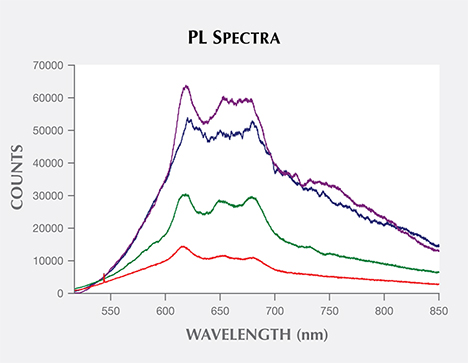
| TABLE 3. F/A peak ratio of natural-color pistachio pearls and four treated samples. |
||
| Sample | F/A ratio | |
| N 01 | 36 | |
| N 02 | 15 | |
| N 03 | 20 | |
| N 04 | 78 | |
| N 05 | 5 | |
| N 06 | 7 | |
| N 07 | 26 | |
| N 08 | 37 | |
| BA 04 (after treatment) | 65 | |
| BA 05 (after treatment) | 112 | |
| BA 06 (after treatment) | 69 | |
| GIA 01 (after treatment) | 70 | |
FTIR and EDXRF Spectra. Like the Raman spectra, the FTIR spectra showed vibrational modes in the mid-IR region related to the mineral aragonite in both untreated and treated Tahitian samples. No further diagnostic features were observed that would help separate the treated and untreated samples. Energy-dispersive X-ray fluorescence (EDXRF) qualitative analysis revealed no foreign trace elements after treatment. Whereas inorganic dyes containing Ag or I may be detected in some dyed black or golden pearls (Elen, 2001), only the major element Ca and the trace element Sr were detected in these samples. Traces of Ni were also reported in some treated pistachio Tahitian cultured pearls previously examined by EDXRF (Lee et al., 2012), but no detectable traces were found in this study.
Stability Tests. The surfaces and colors of the treated samples were largely unchanged after immersing them in various common chemical solvents (acetone, ethanol, and isopropanol) for six hours at room temperature (figure 11), indicating that the treatment applied by Ballerina is generally stable. Further tests and observations are needed to check the long-term stability of these pearls, under both normal and harsh conditions. No color residue or foreign material was observed in the solution, ruling out the possibility that coating materials dissolved from the surface of these treated pearls.
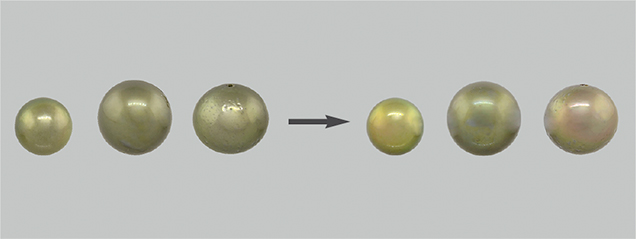
Bleaching Tests. Bleaching tests conducted on the natural-color Tahitian cultured pearls by both solution and cream methods resulted in no obvious color changes (figure 12). The samples generally lost their luster, but their overtones were enhanced after bleaching. This could indicate a change in nacre platelet structure that altered their interference with light (Liu et al., 1999; Snow et al., 2004), or a change to the organic components in between the nacre platelets. Some pearls had a slightly lighter tone after treatment, but the overall effect was subtle and ultimately insignificant. The UV-Vis spectra were virtually identical before and after the bleach test, except for slight differences in the overall reflectance level (possibly due to instrumental variations or changes in luster). Different experimental conditions may be needed for a stronger visual change, but it is more likely that bleaching alone cannot produce the desired pistachio color. A variety of other chemical agents may be involved in the treatment process, which remains proprietary. Additional bleaching tests were conducted on two thin pieces of P. margaritifera shell. These samples displayed a greater degree of color lightening, especially at the edges of the shells, where light brown areas turned silver-white, confirming that hydrogen peroxide is capable of oxidizing the pigment compounds (figure 13). Parts of the shells broke away during the treatment, causing slight changes in their shape and appearance.

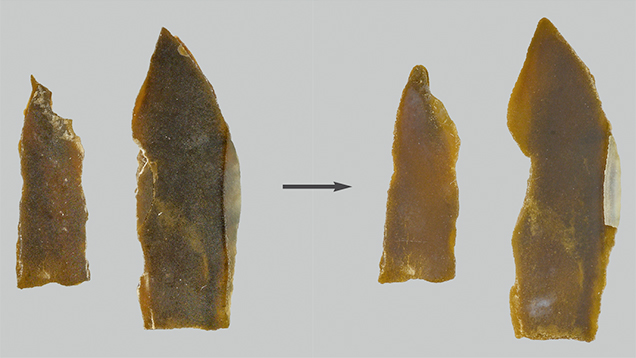
DISCUSSION
Pistachio pearls treated by Ballerina Pearl Co. usually exhibit saturated yellowish green to greenish yellow colors, modified from the natural dark gray colors of Tahitian cultured pearls. Other modified brownish or grayish colors of various saturations may also be produced. Many factors could affect the appearance of the final products, including the presence of various pigments in the starting materials and differences in experimental conditions and durations. According to Ballerina, the pearls were treated for different durations, and some were treated more “aggressively” than others, although the exact experimental conditions were not disclosed. The nature of the pigments responsible for the gray to black color of P. margaritifera shells and pearls can be attributed to melanin-like material (Jabbour-Zahab et al., 1992).
Microscopic examination of treated pistachio pearls did not reveal any dye concentration within or around surface blemishes, indicating that the processes involved differ from “simple” dye treatment. The largely unchanged 700 nm absorption peak, present in Tahitian cultured pearls and found in treated pistachio pearls, supports this conclusion, as the dye would be expected to infiltrate the nacre platelets and affect the absorption at the 700 nm region. Treated pistachio pearls did show a decrease in reflectance toward shorter wavelengths, with deep and broad reflectance troughs at around 405 nm, while both naturally colored dark gray pearls and pistachio pearls often displayed distinct absorption peaks at 405 nm (and sometimes also at 495 nm). This deep and broad absorption feature of treated pearls correlates with their more yellowish appearance and therefore represents an important tool to separate treated pistachio pearls.
Other useful techniques that aid in the identification of Ballerina’s treated pistachio pearls are DiamondView fluorescence imaging and PL acquired with a Raman spectrometer. Both techniques examine the reactions of the pearls’ surfaces and micron-deep surface layers to light excitation using different energy sources. Subtle differences in the PL properties of treated pistachio pearls have been found with the 650 nm feature. Other significant differences were found using the DiamondView, which was originally designed to observe the fluorescence images of diamonds and separate synthetic from natural diamonds. Natural-color Tahitian cultured pearls displayed strong fluorescence, regardless of bodycolor, while treated pistachio pearls showed little or no reaction. The results of the study demonstrated that Raman spectroscopy, EDXRF spectrometry, and FTIR spectrometry were not particularly helpful in separating treated and untreated pistachio pearls.
Bleaching was originally thought to be the main cause of the color change in Tahitian cultured pearls, similar to previously examined chocolate pearls (Wang et al., 2006). The possible presence of melanin pigments in Tahitian cultured pearls led us to hypothesize that the underlying mechanism could be similar to that seen in the bleaching of human hair. It has long been known that the principal pigments of human hair are the brown-black melanins (eumelanins) and the less prevalent red pigments (pheomelanins) (Robbins, 2002). In several studies on the bleaching of melanin compounds (Edman and Sullivan, 1965; Wolfram et al., 1970; Korytowski and Sarna, 1990), hydrogen peroxide has been used to oxidize the melanin compounds under alkaline conditions. The results of this study show that simple bleaching experiments cannot effectively modify the bodycolors of Tahitian cultured pearls, possibly due to the inability of the bleaching liquid and cream to penetrate and disperse into each layer of nacre. Only small changes in body tone and overtone were observed. The effect was more obvious on a thin piece of P. margaritifera shell, where the light brown coloration was whitened in one area, indicating the destruction and removal of pigments by hydrogen peroxide. Contrary to our expectations, bleaching alone did not cause the desired saturated greenish yellow or yellowish green color.
Pearls from P. margaritifera may contain more complex mixtures of pigments than just melanin. Porphyrin or uroporphyrin compounds may also be present, and these are responsible for the 405 nm absorption peak observed using UV-Vis-NIR reflectance spectroscopy (e.g., Miyoshi et al., 1987; Iwahashi and Akamatsu, 1994; Karampelas et al., 2011a,b). Porphyrin molecules are remarkably stable and have been found in fossilized shells. Some traces of porphyrins can combine with metals, while others are found in free form in mollusks. Previous studies have found that green pearls contain greater proportions of metalloporphyrins than pink pearls (Fox, 1979). Our UV-Vis spectra of treated pistachio pearls showed a more significant change in the 405 nm region, which suggests that the treatment had a stronger effect on porphyrin pigments than melanin pigments. The overall appearance of the finished products depends on the total concentrations and proportions of various pigments and the interference of light by nacre platelets, and the treatment may achieve this by modifying or removing certain pigments from the pearls.
CONCLUSIONS
This study has demonstrated that pistachio-colored pearls grown within P. margaritifera and treated by Ballerina Pearl Co. may be identified by their unique appearance, as well as by nondestructive advanced instrumental techniques such as UV-Vis-NIR reflectance spectroscopy, Raman photoluminescence, and DiamondView imaging. Indications of treatment may include significant and broad absorption features around 405 nm, a less-defined 650 nm PL feature under 514 nm wavelength laser excitation and relatively high F/A ratio, and weak or inert fluorescence reactions under the DiamondView. Pistachio pearls treated by other companies may or may not show the same results, depending on the processes involved (Lee et al., 2012).
This study has also indicated that bleaching is not likely to be the main color-change mechanism in this treatment. The processes may involve more sophisticated chemical and physical techniques that can turn the dark gray color to a stable pistachio color, but no indications of dyeing were detected. These pistachio colors are generally stable when exposed to common household chemicals such as ethanol, acetone, and isopropanol. Continuing studies on the effects of different chemical agents or other techniques such as heating and irradiation on the color of Pinctada margaritifera pearls are needed to further understand the mechanism of this color change.
.jpg)


